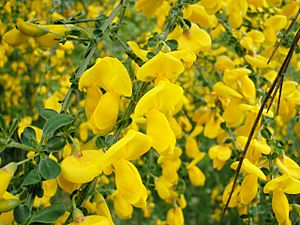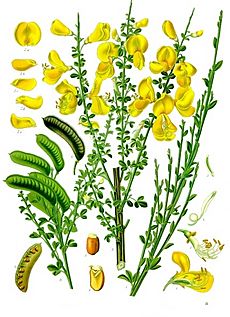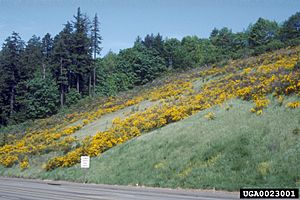Cytisus scoparius facts for kids
Quick facts for kids Cytisus scoparius |
|
|---|---|
 |
|
| Common broom | |
| Scientific classification | |
| Genus: |
Cytisus
|
| Species: |
scoparius
|
| Synonyms | |
|
List
|
|
The common broom (also known as Cytisus scoparius or Scotch broom) is a type of shrub that lives for many years. It belongs to the legume family, like peas and beans. This plant originally comes from western and central Europe.
In places like Britain and Ireland, people usually just call it "broom." But because other similar plants are also called broom, sometimes people say "common broom" to be clear. In other countries, like the United States, it's often called "Scotch broom." In Australia, it's known as "English broom."
Contents
What is Common Broom?
How to Identify Common Broom
Common broom plants usually grow to be about 1 to 3 meters (3 to 10 feet) tall. Sometimes they can even reach 4 meters (13 feet)! Their main stems can be as thick as 5 centimeters (2 inches).
The stems are green and have ridges. The plant has small, green leaves that fall off in the autumn. These leaves are about 5–15 millimeters long. In spring and summer, the common broom is covered in many bright golden yellow flowers. These flowers are about 20–30 millimeters tall and 15–20 millimeters wide.
After the flowers, the plant grows seed pods, which are a type of legume. These pods are black when they are ripe, about 2–3 centimeters long. They burst open with a loud crack, throwing their seeds away from the parent plant. This helps the plant spread its seeds far and wide.
Where Does Common Broom Grow?
Common broom likes sunny places and usually grows in dry, sandy soils. It can even grow in very acidic soil. This plant is good at living in areas with a Mediterranean climate, which means warm, dry summers and mild, wet winters. Young plants and seeds are sensitive to frost, but older plants can handle colder weather better.
Like other legumes, common broom can help the soil. It has a special relationship with tiny bacteria called Rhizobium. These bacteria live in the plant's roots and help it take nitrogen from the air and put it into the soil. This process is called nitrogen fixation, and it makes the soil richer.
Different Types of Common Broom
There are two main types, or subspecies, of Cytisus scoparius:
- Cytisus scoparius subsp. scoparius: This is the most common type found across the plant's natural range.
- Cytisus scoparius subsp. maritimus: This type grows in Western Europe, especially on sea cliffs. It's much shorter, usually less than 0.4 meters (1.3 feet) tall, and has fuzzy young shoots.
Growing Common Broom
Common broom is often grown as an ornamental plant in gardens because of its beautiful flowers. There are many different types, called cultivars, that gardeners can choose from. Some have different flower colors, like "Moonlight" with deep yellow flowers, or "Andreanus" and "Firefly" with dark orange-red flowers. Others have different growth habits, like "Pendula," which has branches that hang down.
Common Broom as an Invasive Plant
Outside of its native home in Europe, common broom has become a big problem in many parts of the world. It's considered an invasive species in places like North America (especially California, Oregon, Washington, and British Columbia), Australia, New Zealand, and India.
When common broom grows in new areas, it can take over quickly. It often grows in places where the land has been disturbed, like along roads or after trees have been cut down. Its fast growth can stop new trees from growing, which is a problem for forests. For example, in Oregon, it's estimated to cause millions of dollars in lost timber production each year. In New Zealand, it costs the forestry and farming industries a lot of money too.
How to Control Invasive Broom
Scientists and land managers use different methods to control common broom. One way is called biological control. This means using natural enemies, like insects, to help stop the plant from spreading. Some insects that have been tested include:
- The broom twig miner (Leucoptera spartifoliella)
- The broom seed beetle (Bruchidius villosus)
- The broom gall mite (Aceria genistae)
- The sap-sucking broom psyllid (Arytainilla spartiophila)
- The Scotch broom seed weevil (Exapion fuscirostre)
- The broom leaf beetle (Gonioctena olivacea)
- The broom shoot moth (Agonopterix assimilella)
Another way to remove broom is by cutting it, pulling it out, or using special chemicals. It's important to be careful not to disturb the ground too much, especially when the plants are making seeds. This is because disturbing the soil can cause more seeds to sprout. Sometimes, new plants will grow from the roots or from seeds, so people often need to treat the area more than once.
Interesting Facts and History
Plant Chemicals
Common broom contains natural chemicals called alkaloids. These chemicals can be harmful if eaten. They help protect the plant from insects and animals that might try to eat it.
Old Uses of Broom
In the past, people used parts of the broom plant for different purposes. For example, it was sometimes used to help the body get rid of extra water. An ointment made from the flowers was also used to treat certain conditions. However, because the plant contains toxic chemicals, it's not safe to use without expert knowledge.
Broom in Stories and Legends
In Welsh mythology, there's a story about a woman named Blodeuwedd. She was created from the flowers of broom, meadowsweet, and oak trees. Her story is part of an old Welsh tale called Math son of Mathonwy.
People also had beliefs about broom in folklore. If a broom plant had many flowers, it was seen as a sign of good fortune. However, a traditional rhyme from Sussex, England, warned against sweeping the house with broom flowers in May, as it was thought to bring bad luck to the head of the household. Broom was also sometimes used in wedding decorations. In Italy, people believed burning broom could keep witches away.
Royal Connections
The name of the House of Plantagenet, a famous family of English rulers in the Middle Ages, might have come from the common broom. In Latin, the plant was called planta genista. Geoffrey V of Anjou used the broom plant as his special heraldic badge. Five Plantagenet kings of England also used it as a royal emblem. Even the broomscod, which is the seed pod of the plant, was a personal symbol for Charles VI of France.
See also
 In Spanish: Cytisus scoparius para niños
In Spanish: Cytisus scoparius para niños



